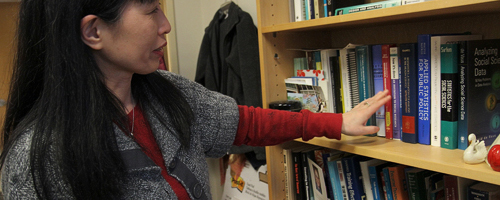From its humble beginnings as an extension center, educating primarily World War II veterans in an abandoned shipyard housing project, Portland State has survived everything from legislative resistance to floods and riots in its climb to its present state of being.
We started from nothing
From its humble beginnings as an extension center, educating primarily World War II veterans in an abandoned shipyard housing project, Portland State has survived everything from legislative resistance to floods and riots in its climb to its present state of being.
Stephen E. Epler, the dedicated founder who fought to devolve the school into a permanent, degree-granting institution, initially wrote to his incoming faculty, “As you know, we are starting from nothing.”
Today, PSU is a university recognized as a leader in sustainability and as a key institute of higher education in the Portland metropolitan area. It also remains a welcoming place of learning for people from all walks of life.
But what made PSU the university that dominates 49 acres of Portland’s southwest downtown district? Here’s a brief look at many of the events that shaped the university over time.
1946: The Vanport Extension Center, predecessor to PSU, is founded in Vanport City, a wartime housing project between Portland and Vancouver, Washington.
1948: The Columbia River floods on May 30, killing 15 people and destroying the entire city of Vanport, including the Vanport Extension Center. The college survives, moving to Grant High School for the summer term and ultimately to the Oregon Shipyard Corporation’s administration building in St. John’s for fall. The college is nicknamed “Oregon Ship” by students.
1949: After lengthy legislative battles, Epler and John Hakanson achieve permanency for Vanport.
1952: Vanport, now the Portland State Extension Center, moves to Lincoln High School in the Park Blocks of downtown Portland. The building is dubbed “Old Main.”
1955: Governor Paul Patterson signs legislation making PSU a four-year institution on Feb. 10. John Francis Cramer, dean of the general extension division of higher education, is named the first president of Portland State College.
1959: President Branford Millar succeeds Cramer and begins oversight of the administration that will process the first major expansion of campus beyond Portland’s South Park Blocks.
1961: State Hall (now Cramer Hall) and Smith Center completed.
1965: Portland State receives a federal grant for urban renewal, resulting in the eventual acquisition of properties west to 11th Avenue and east beyond Broadway (today’s University Services Building). The renewal project edges out many long-established local businesses.
1967: Construction of Millar Library completed.
1969: PSU achieves university status and is renamed Portland State University.
1970: American war efforts in Cambodia and the subsequent Kent State massacre in Ohio lead to a student boycott of classes. The initially peaceful engagement ultimately erupts to wide-scale protests, barricades and police violence in the South Park Blocks.
1975: PSU’s Women’s Studies Certificate Program is approved.
1976: The School of Urban and Public Affairs is created.
1982: The Schools of Fine and Performing Arts and Liberal Arts are formed from existing programs and departments.
1988: PSU opens the School of Business Administration Building.
1994: PSU launches the University Studies undergraduate curriculum.
1995: The Pacific Rim Economic Conference brings CEOs and top U.S. government officials to PSU, including President Bill Clinton and Vice President Al Gore.
2002: The Campus Sustainability Office is founded to help establish and maintain an institution-wide culture of
sustainability.
2004: Policies are put in place to require LEED (Leadership in Energy and Environmental Design) certification for all new construction and major renovations to campus buildings.
2005: Stephen Epler Hall (constructed on the site of the Birmingham Building in 2003) and the Broadway Building (newly constructed in 2004) achieve LEED silver certification, the first of their kind on campus.
2008: The James F. and Marion L. Miller Foundation awards PSU a $25 million challenge grant, the largest gift in PSU history, in support of the university’s academic, research and engagement activities in sustainability. Wim Wiewel is named PSU’s eighth president.
2010: PSU Institute for Sustainable Solutions is established to promote sustainable research and administer the Miller Foundation grant.
2011: Lincoln Hall, the site of PSU’s first downtown home, receives LEED platinum certification upon completion of modern renovations.
2012: Portland’s City Council approves the establishment of an education urban renewal district, to result in $50 million going to PSU for capital projects.



